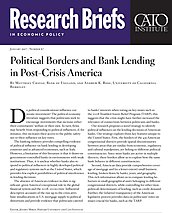Do political considerations influence corporate investment? The political economy literature suggests that politicians seek to encourage investments that increase either their constituents’ welfare or their own. In turn, firms may benefit from responding to political influences, if, for instance, this increases their access to the public safety net or their influence on key votes.
The banking industry provides compelling evidence of political influence on bank lending in developing countries and in advanced economies, such as Italy. However, a limitation of this literature is that it draws on government-controlled banks in environments with weak institutions. Thus, it is unclear whether banks also respond to political influences in highly developed political and regulatory systems such as the United States, which provides few explicit possibilities of political interference in lending decisions.
The absence of American evidence to date is significant, given America’s exceptional role in the global financial system and the 2008–2009 crisis. Influential descriptive accounts of the run-up to the crisis attribute misallocations in U.S. mortgage supply to political distortions and provide evidence that politicians catered to banks’ interests when voting on key issues such as the 2008 Troubled Assets Relief Program (TARP); this suggests that the crisis might have further increased the relevance of connections between politicians and banks. Our research proposes a novel strategy to identify political influences on the lending decisions of American banks. Our strategy exploits three key features unique to the United States. First, the borders of the 435 American congressional districts provide spatial discontinuities between areas that are similar from economic, regulatory, and cultural standpoints, yet belong to different political constituencies. Since most banks are active in multiple districts, these borders allow us to explore how the same bank behaves in different constituencies.
Second, American data provide comprehensive coverage of mortgage and (to a lesser extent) small business lending, broken down by banks, years, and geography. This rich information allows us to compare lending behaviors in small geographical units belonging to different congressional districts, while controlling for other (nonpolitical) determinants of lending, such as credit demand. Further, the (relative) transparency of the American legislative process provides data on politicians’ votes on issues crucial for banks, such as the TARP.
Finally, the TARP provides a shock to the political connections between banks and politicians. This unprecedented injection of public capital into U.S. banks did not formally allow Congress to affect participants’ lending decisions. However, anecdotal evidence suggests that Congress could exert informal pressures via media appearances, congressional hearings, or threats to impose “lending mandates” on recipients. Importantly, evidence also suggests that some members of Congress helped banks headquartered within their districts to get through the TARP application process. This suggests that informal pressures, or the threat thereof, may be particularly prevalent in markets inside the congressional district of the representative for the area in which the bank is headquartered (the bank’s “home district”).
We use 2006–2010 annual data on bank-county-level mortgage lending growth to examine this idea empirically. Our baseline model compares the mortgage growth of TARP recipients compared to other banks after the TARP (as opposed to before) in areas located inside the district of their home representative (not elsewhere). We do this controlling for other possible determinants of TARP participation, such as credit demand.
We find that TARP recipients increased mortgage lending by 23 percent to 60 percent more inside the district of their home Congressional representative; lending in areas outside of the home district stayed flat or fell, whereas lending inside the home districts increased substantially. This “home-district effect” is not explained by public loan guarantees or loan purchases by government sponsored enterprises such as Fannie Mae or Freddie Mac, gerrymandering, or a post-crisis home-district bias. In addition to our baseline estimates, we also find similar results using a matched sample of banks based on their pre-crisis propensities to participate in the TARP. The home-district effect also holds in a wholly different dataset of small business lending. In contrast, the effect disappears when we falsify the timing of the TARP or the precise geographical location of congressional district borders.
We then explore how the home-district effect varies with the intensity of the connection between recipients and their home-district representative. We find that the home-district effect only holds if a representative supported the TARP bill in Congress. The home-district effect is also stronger if the TARP supporter was reelected in the 2008 elections and thus able to influence recipients. Finally, the effect is stronger if the representative received substantial campaign contributions from the financial industry—a proxy for the representative’s sensitivity to banks’ special interests in congressional votes. Together, these results are consistent with political considerations affecting the lending choices of beneficiaries of TARP, in particular if the “flows” between a bank and a politician are reciprocal.
Note:
This research brief is based on Matthieu Chavaz and Andrew K. Rose, “Political Borders and Bank Lending in PostCrisis America,” NBER Working Paper no. 22806, November 2016, http://www.nber.org/papers/w22806. This work represents only the authors’ views, not the Bank of England’s.
